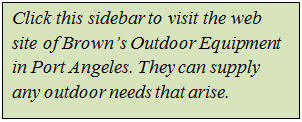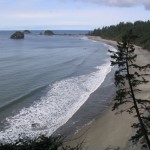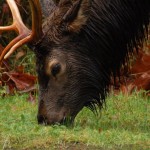A visit to Olympic National Park requires accepting the fact that it rains in the Pacific Northwest—a lot. That is, when the sun isn’t shining. Yes, in spite of the reputation that it rains here, all the time, there is a generally guaranteed sunny period, most commonly from mid-July until mid-September. As for the other ten months of the year, the rain in the Park can be generalized as frequent periods, of several days, where a persistent “fat-drizzle” best describes the condition. What rarely happens—usually only 3 or 4 times a year and usually in October through January—are huge pounding rain and wind events; the type that keep even “rain-savvy” Pacific Northwesterners indoors.
Preparation for the possibility of rain, which can occur any day of the year, requires three things:
- some form of rainwear,
- acceptance that rain might be part of a good experience,
- the expectation of seeing something that can only be seen when it rains.
Rainwear doesn’t have to be a heavy storm suit or even include an umbrella. Oftentimes an inexpensive thin poncho or rain jacket, the type that stuffs into its own pocket for storage, will do for a short outing.  Add a waterproof or resistant hat with a brim that runs all the way around, and a pair of water resistant shoes to the list. Sometimes just a change of shoes and socks will suffice.
Add a waterproof or resistant hat with a brim that runs all the way around, and a pair of water resistant shoes to the list. Sometimes just a change of shoes and socks will suffice.
Accepting the fact that it’s raining is like putting jelly on a sandwich because the jam is all gone; it’s a condition that asks for flexibility and can be answered with an accepting smile. The point is to stay comfortable and relatively—not bone—dry. Rain in and of itself is not to be avoided. After all, if it didn’t rain in the Park it would not be the spectacular place that it is. Each year three million people adapt and accept the rain, if encountered, as just another natural attribute of an unforgettably special place.
As the two-month dry season wears on, subtle changes begin to occur in the wet areas of the Park. In the rain forest, in particular, plants that are routinely accustomed to regular watering begin to shrivel and lose some of their vibrancy, as they attempt to protect themselves from the adversity of dry weather. Banana Slugs and the Arionid Jumping Slugs, found only in the Park, seek shelter in and under the cover of damp plant debris on the forest floor. (Please step politely over these natives to the Park bravely crossing a forest freeway that to visitors is merely a trail.)
The experience of a cool, damp, quiet day can come alive on a lake shore watching waterfowl glide through the exquisite circular patterns caste by every drop of rain. On a rock outcropping, discover a newborn rivulet slake the thirst of a rock flower perched fortuitously in the water’s infrequent summer path. Watch the mist roll up the meadow or the sea stacks appear and disappear with the mystical undulations of the fog. Cast eyes up the valley and enjoy the unfolding drama of silky grey curtains of rain falling from the silver sky. These experiences cannot be enjoyed when the sky is blue and the air is blown dry on the sun’s radiant wind.
Blue sky days are a treat we all appreciate, but in the mountains or on the beach they can mask dangers and hardships often recognized only after damage has been done. Heat and lower humidity can cause excessive loss of body fluids through respiration and perspiration, causing dehydration when fluid intake isn’t sufficient. (Avoid caffeine and alcohol, since they only serve to make for greater loss of fluids.) Additionally, at higher altitudes frequently experienced by Park visitors, the atmosphere is thinner and so exposure to higher levels of UV radiation (and the potential for sunburn) is common. Skin and eyes need protection, especially when traveling on snow or open water. Sunburn is a constant threat, but the reflective quality of both snow and water can magnify the risk. UV reflected up off bright and shiny surfaces can cause sunburn on areas usually not exposed to the sun’s rays—inside the nostrils, under the chin, inside ears, and under the arms. Apply sunscreen liberally to these areas, and wear wrap-around sunglasses to avoid snow blindness.
The moral here is: heed the warning or pay the price, part of which may be the loss of the precious joy that might otherwise have settled into a pleasant place among the memories.
For more information about the dangers of UV exposure, read the following FAQ on the World Health Organization’s website:



